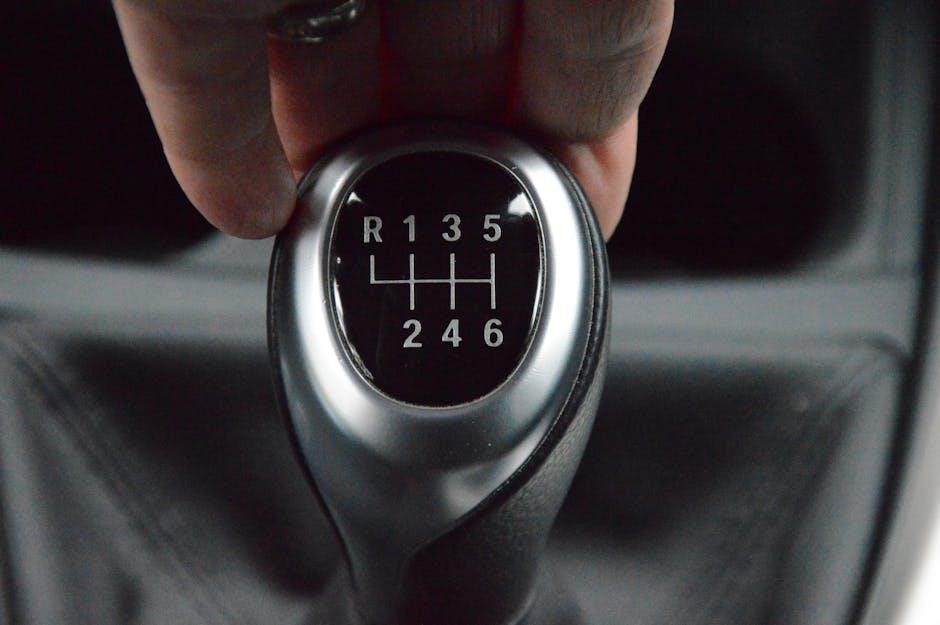
The Minnesota Drivers Manual 2024 is a comprehensive guide covering road rules‚ traffic laws‚ and safe practices. It’s essential for new drivers‚ offering updated information‚ interactive features‚ and accessible formats to help prepare for licensing and safe driving in Minnesota.
Purpose of the Minnesota Drivers Manual
The Minnesota Drivers Manual 2024 serves as an official guide to help residents understand traffic laws‚ road signs‚ and safe driving practices. It is designed to prepare applicants for the knowledge and vision tests required for obtaining a driver’s license. The manual also promotes road safety by educating drivers on defensive techniques‚ distracted driving laws‚ and emergency procedures. Regular updates ensure the manual reflects current regulations and programs‚ such as the “Drivers License for All” initiative. It is a vital resource for new and experienced drivers alike‚ fostering safer roads across Minnesota.
Key Features of the 2024 Edition
The 2024 Minnesota Drivers Manual includes updated road rules‚ traffic laws‚ and safety guidelines. It features an audio version and translations for accessibility. Enhanced sections on distracted driving and impaired driving laws are highlighted‚ along with detailed application processes for standard and special licenses. Interactive study tools and AI assistance are now available to aid test preparation. The manual also outlines the “Drivers License for All” program‚ allowing all residents to apply regardless of immigration status. These features ensure a comprehensive and inclusive guide for drivers in Minnesota.
Where to Access the Minnesota Drivers Manual
The Minnesota Drivers Manual 2024 can be downloaded as a PDF or viewed online for free. It is available on the official Minnesota DMV website and through www.MNDriversManuals.com. Physical copies can be picked up at any Minnesota DMV office or Anoka County License Centers. The manual is also accessible in multiple languages and audio formats to accommodate diverse needs. Additionally‚ interactive study tools and AI assistance are provided online to enhance preparation for the knowledge test. This ensures easy access for all residents preparing to drive in Minnesota.

Understanding the Licensing Process in Minnesota
The Minnesota Drivers Manual 2024 guides residents through the licensing process‚ including eligibility‚ application steps‚ required documents‚ and tests. It outlines new laws like “Drivers License for All‚” ensuring accessibility for all Minnesotans‚ regardless of immigration status‚ and provides detailed instructions for obtaining permits‚ licenses‚ and special licenses‚ such as limited‚ farm work‚ or medical licenses‚ ensuring a clear path to legal driving privileges in the state;
Types of Driver’s Licenses in Minnesota
Minnesota offers various driver’s licenses to suit different needs. The most common is the Class D License‚ for non-commercial vehicles. A Commercial Driver’s License (CDL) is required for heavy vehicles‚ while a Motorcycle License is needed for two-wheelers. Special licenses include Limited Licenses for restricted driving privileges‚ Farm Work Licenses for agricultural purposes‚ and Medical Reason Licenses for those with specific medical conditions. The “Drivers License for All” law now allows all Minnesotans‚ regardless of immigration status‚ to obtain a standard license‚ ensuring inclusive access to driving privileges.
Eligibility Requirements for a Minnesota Driver’s License
To apply for a Minnesota driver’s license‚ applicants must meet specific eligibility criteria. Individuals must be at least 15 years old to apply for an instruction permit and 16 years old to obtain a provisional license. Applicants under 18 years old must complete a state-approved driver’s education course. Vision and knowledge tests are mandatory for all applicants. Proof of identity and residency is required‚ with documents such as a birth certificate‚ Social Security card‚ and utility bills. Under the “Drivers License for All” law‚ applicants of any immigration status can apply‚ starting October 1‚ 2023.
Step-by-Step Application Process
The process to obtain a Minnesota driver’s license involves several structured steps. First‚ applicants must gather required documents‚ including proof of identity‚ residency‚ and legal presence. Next‚ they must pass a vision test and complete a knowledge test‚ which covers traffic laws and road signs. For applicants under 18‚ a driver’s education course is mandatory. After passing these tests‚ a learner’s permit is issued. Following the required practice period‚ a road test is scheduled and must be passed to obtain a provisional or full driver’s license. The process ensures compliance with state regulations and safe driving practices.
Required Documents for License Application
To apply for a Minnesota driver’s license‚ applicants must provide specific documents. These include proof of identity‚ such as a birth certificate or valid passport‚ and proof of residency‚ like a utility bill or bank statement. Additional documentation‚ such as a Social Security card‚ may also be required. For applicants under 18‚ parental consent is necessary. For those over 21‚ different requirements apply. The Drivers License for All law allows applicants to use alternative documents regardless of immigration status. Check the official DPS website for the most accurate and updated list of required documents.
Fees Associated with Obtaining a Driver’s License
The fees for obtaining a Minnesota driver’s license vary based on the type of license and applicant status. As of 2024‚ the Minnesota Legislature has increased fees by 6% for all credentials‚ including driver’s licenses and ID cards. Payment methods accepted include cash‚ credit cards‚ and checks. These fees cover administrative costs‚ road safety initiatives‚ and program improvements. For detailed fee structures‚ visit the official Minnesota DPS website or consult your local DMV office for accurate and updated pricing information.

Road Rules and Traffic Laws in Minnesota
The Minnesota Drivers Manual 2024 outlines essential road rules and traffic laws‚ including speed limits‚ right-of-way guidelines‚ and safety regulations. It emphasizes adherence to traffic signals‚ seat belt laws‚ and defensive driving practices to ensure road safety and compliance with state regulations.
General Road Rules and Regulations
The Minnesota Drivers Manual 2024 details essential road rules‚ including speed limits‚ traffic signal obedience‚ and right-of-way protocols. Drivers must adhere to posted speed limits‚ yield to pedestrians and emergency vehicles‚ and avoid reckless behaviors like texting while driving. Proper lane usage‚ turning procedures‚ and following traffic signs are emphasized to ensure safety. The manual also covers prohibited practices‚ such as passing stopped school buses or ignoring traffic control devices. Understanding these rules is crucial for safe driving and avoiding citations. The manual serves as a guide to help drivers navigate Minnesota roads confidently and responsibly.
Speed Limits and Traffic Signals
The Minnesota Drivers Manual 2024 outlines speed limits and traffic signal rules to ensure safe driving. Speed limits vary by location‚ with lower limits in urban areas and school zones. Drivers must obey traffic signals‚ including red lights‚ green lights‚ and yellow cautions. Right-of-way rules at intersections and crosswalks are emphasized to prevent accidents. The manual also highlights penalties for speeding and running red lights‚ stressing the importance of adhering to these regulations for road safety. Understanding and following these guidelines is essential for responsible driving in Minnesota.
Seat Belt and Safety Laws
The Minnesota Drivers Manual 2024 emphasizes the importance of seat belt and safety laws to protect all road users. All drivers and passengers must wear a seat belt‚ and children under 8 years old or shorter than 4 feet 9 inches must use a child safety seat. Failure to comply results in fines and penalties. The manual also highlights the risks of distracted driving and the need for drivers to remain vigilant. These laws are designed to reduce injuries and fatalities‚ ensuring safer roads for everyone in Minnesota.
Right-of-Way Rules
Right-of-way rules in Minnesota are designed to ensure smooth traffic flow and prevent accidents. Drivers must yield to pedestrians at crosswalks and to emergency vehicles with flashing lights or sirens. At four-way stops‚ the first vehicle to arrive goes first‚ or the vehicle on the right if arrival is simultaneous. When entering a roundabout‚ yield to traffic already in the circle. Always give way to oncoming traffic when turning left. Understanding these rules is crucial for safe and responsible driving in Minnesota.

Safe Driving Practices
Safe driving practices include regular vehicle maintenance‚ adjusting speed for weather conditions‚ and staying patient and courteous to ensure a safe environment for all road users.
Defensive Driving Techniques
Defensive driving techniques emphasize anticipation and caution to minimize risks on the road. Key strategies include maintaining a safe distance‚ scanning surroundings‚ and anticipating other drivers’ actions. Avoid distractions like texting or aggressive behaviors‚ and always be prepared to react. Adjust speed according to road conditions and weather. Stay alert to potential hazards‚ such as pedestrians or vehicles cutting into your lane. By staying focused and patient‚ drivers can significantly reduce the likelihood of accidents and ensure a safer driving environment for everyone.
Distracted Driving Laws and Prevention
Minnesota’s distracted driving laws aim to reduce accidents caused by inattentive driving. The 2024 manual highlights strict penalties for texting‚ browsing‚ or using handheld devices while driving. Prevention strategies include designating a passenger to handle calls‚ using phone apps that block distractions‚ and keeping eyes on the road. Drivers are encouraged to avoid eating‚ grooming‚ or engaging in conversations that divert attention. Employers and parents are urged to promote distraction-free driving habits. By staying focused‚ drivers can significantly enhance road safety and comply with state regulations.
Impaired Driving Laws and Consequences
Minnesota enforces strict impaired driving laws to protect road safety. The 2024 manual emphasizes penalties for driving under the influence (DUI) or driving while intoxicated (DWI). A blood alcohol concentration (BAC) of 0.08% or higher results in criminal charges. Underage drivers face stricter penalties for any detectable alcohol use. Consequences include license suspension‚ fines‚ and potential jail time. Repeat offenses may require ignition interlock devices. The manual highlights the importance of planning safe rides and never driving impaired to avoid devastating consequences for both drivers and others on the road.
Emergency Procedures and Crash Reporting
In case of an accident‚ the Minnesota Drivers Manual 2024 outlines essential steps to ensure safety and comply with the law. Drivers must remain calm‚ secure the scene‚ and exchange information with all parties involved. Reporting the crash to authorities is mandatory if it results in injury‚ death‚ or significant property damage. The manual emphasizes the importance of notifying law enforcement promptly and filing a crash report within 10 days. Understanding these procedures helps drivers handle emergencies responsibly and avoid legal consequences for non-compliance.

Preparing for the Knowledge Test
The Minnesota Drivers Manual 2024 is a key resource for preparing for the knowledge test‚ offering detailed study tips‚ practice questions‚ and essential insights into road signs and traffic laws to ensure readiness and confidence for the exam.
What to Expect on the Minnesota Knowledge Test
The Minnesota Knowledge Test evaluates understanding of road rules‚ traffic signs‚ and safe driving practices. It consists of 40 multiple-choice questions‚ requiring a score of at least 32 to pass. Topics include speed limits‚ right-of-way rules‚ and traffic signals. The test is available in multiple languages and formats‚ including audio for accessibility. Study the Minnesota Drivers Manual 2024 thoroughly‚ as it covers all essential information. Practice tests and interactive tools are also available to help prepare effectively and build confidence for the exam.
Study Tips for Passing the Test
Effectively studying the Minnesota Drivers Manual 2024 is key to success. Highlight and review key sections‚ such as road rules and traffic signs. Utilize practice tests to assess knowledge and identify weak areas. Take advantage of the manual’s interactive features‚ including audio versions for auditory learners. Break study sessions into manageable chunks and focus on understanding concepts rather than memorizing. Use the AI assistant for clarifying complex topics and ensuring comprehension. Regularly review mistakes to avoid repeating errors. Consistent practice and thorough preparation will build confidence for the test.
Retaking the Test if Failed
If you fail the Minnesota knowledge test‚ you can retake it after a mandatory waiting period. Review the manual thoroughly‚ focusing on areas where mistakes were made. Practice tests and interactive tools can help identify and improve weak spots. A retesting fee may apply‚ so check current DMV fees. Use the AI assistant for additional support and clarification on complex topics. Understanding your errors is crucial for success on the next attempt. Stay calm‚ and ensure you’re well-prepared before retaking the test to achieve the best results.

Understanding the Vision Test
The vision test ensures Minnesota drivers can safely operate vehicles. It assesses visual acuity and peripheral vision‚ with accommodations available for impairments to promote road safety.
Importance of the Vision Test
The vision test is crucial for ensuring drivers can operate vehicles safely. It assesses visual acuity and peripheral vision‚ which are essential for detecting road hazards‚ reading signs‚ and reacting to situations. Clear vision helps drivers maintain focus and react quickly‚ reducing the risk of accidents. The test ensures that all drivers meet minimum standards to operate vehicles legally and safely‚ safeguarding both the driver and other road users. It is a fundamental step in the licensing process and a key component of road safety in Minnesota.
Standards for Passing the Vision Test
To pass the vision test in Minnesota‚ drivers must meet specific standards. Visual acuity must be at least 20/40 in both eyes combined or 20/70 in each eye individually. Peripheral vision must be at least 105 degrees in each eye. Corrective lenses are permitted if needed. Drivers with certain vision impairments may be eligible for accommodations. Meeting these standards ensures drivers can safely operate a vehicle‚ detect hazards‚ and respond to traffic conditions effectively. These requirements are designed to promote road safety and are strictly enforced during the licensing process.
Accommodations for Vision Impairments
Minnesota provides accommodations for drivers with vision impairments. Those using corrective lenses or bioptic telescopes may apply for a restricted license. Visual field and acuity requirements are adjusted for individuals with impairments. The DMV works with medical professionals to assess eligibility and ensure road safety. Adaptive equipment and specialized testing procedures are available to support drivers with unique vision needs‚ promoting equal access to licensing while maintaining public safety standards on Minnesota roads.

Driver’s License Forms and Documents
The Minnesota Drivers Manual 2024 details forms and documents for standard‚ limited‚ farm work‚ and medical licenses‚ ensuring accessibility online or at DMV locations statewide.
Required Documents for Application
To apply for a Minnesota driver’s license‚ you must provide specific documents‚ including proof of identity‚ residency‚ and legal presence. The 2024 manual outlines acceptable documents‚ such as birth certificates‚ Social Security cards‚ and utility bills. The “Drivers License for All” law allows applicants to use alternative documents regardless of immigration status. Ensure all documents are valid and not expired to avoid delays. Additional requirements may apply for special licenses‚ such as medical or farm work licenses. The manual also provides details on how to obtain and submit these documents efficiently.
Forms for Special Licenses (Limited‚ Farm Work‚ Medical)
The Minnesota Drivers Manual 2024 provides guidance on obtaining special licenses such as Limited‚ Farm Work‚ and Medical licenses. Each requires specific forms and documentation. Limited licenses are for drivers with restrictions‚ while Farm Work licenses are for agricultural purposes. Medical licenses are issued after meeting medical requirements. Forms are available online or at DMV offices. Applicants must submit completed forms along with supporting documents to qualify. The manual details eligibility criteria and application steps for these specialized licenses‚ ensuring compliance with state regulations.
How to Access and Complete Forms
To access forms for driver’s licenses‚ permits‚ or special licenses‚ visit the Minnesota DMV website or pick up copies at local DMV offices. Forms are available for free online or for purchase. Complete forms accurately‚ ensuring all required fields are filled. Submission can be done in person or by mail‚ depending on the type of application. The Minnesota Drivers Manual 2024 provides detailed instructions for each form‚ including checklists for required documents. Assistance is available for completing forms‚ and audio versions are accessible for those with visual impairments.

Special Licensing Programs
Minnesota offers special licenses‚ such as limited‚ farm work‚ and medical reason licenses‚ tailored to specific needs. These programs provide flexible options for diversedriver requirements.
Limited License: Eligibility and Application
A limited license in Minnesota is designed for drivers who need restricted driving privileges due to specific circumstances. Eligibility varies but often applies to individuals with revoked or suspended licenses who can demonstrate a need to drive for essential purposes‚ such as work or school. To apply‚ candidates must submit a completed limited license application form‚ provide required documentation‚ and pay the associated fees. Additional requirements may include proof of insurance or completion of a driver improvement course. The Minnesota Drivers Manual 2024 provides detailed guidance on the process and eligibility criteria.
Farm Work License: Requirements and Restrictions
The Farm Work License is designed for individuals employed in agricultural activities. Eligibility includes being at least 15 years old and providing proof of farm employment. The license restricts driving to farm-related tasks and may limit vehicle types. Applicants must submit a completed application‚ proof of insurance‚ and employer verification. The license is valid only for work-related driving‚ and holders must adhere to all traffic laws. The Minnesota Drivers Manual 2024 outlines specific requirements and restrictions for this specialized license‚ ensuring compliance with state regulations while supporting agricultural needs.
Medical Reason Licenses: Process and Documentation
A Medical Reason License is issued to individuals with medical conditions requiring special accommodations. Applicants must submit a Medical Examiner’s Certificate and a completed application. Documentation includes a physician’s statement verifying the condition and its impact on driving ability. The DMV reviews each case to determine eligibility and restrictions. Restrictions may include time limits or specific driving conditions. This license ensures safe driving while accommodating medical needs‚ as outlined in the Minnesota Drivers Manual 2024. Proper documentation and approval are essential for issuance.
Requesting a Variance from Licensing Procedures
Minnesota allows individuals to request a variance from standard licensing procedures under specific circumstances. A formal request must be submitted‚ detailing the reason for the variance and providing supporting documentation. This process is typically used for medical conditions or other special cases. The DMV reviews each request on a case-by-case basis to determine eligibility. Proper documentation‚ such as medical records or legal papers‚ is essential. This process ensures fair consideration of unique situations while maintaining compliance with state licensing standards‚ as outlined in the Minnesota Drivers Manual 2024.

Fees and Payment Methods
The Minnesota DMV accepts various payment methods‚ including credit cards‚ cash‚ and checks. Fees for licenses and permits increased by 6% in 2024‚ supporting road safety initiatives statewide.
Fee Increases for 2024
The Minnesota Legislature implemented a 6% increase in fees for driver’s licenses‚ ID cards‚ and permits starting October 1‚ 2023. These changes apply to standard‚ REAL ID‚ and enhanced credentials. The fee adjustments aim to support road safety initiatives‚ improve infrastructure‚ and enhance transportation services across the state. The updated fees ensure the Minnesota Department of Public Safety can maintain and expand essential programs for drivers and public safety. Payment methods remain flexible‚ including credit cards‚ cash‚ and checks at DMV locations.
Payment Methods Accepted by the DMV
The Minnesota DMV accepts various payment methods for driver’s licenses‚ ID cards‚ and permits. Credit cards‚ including Visa‚ MasterCard‚ and Discover‚ are accepted at most locations. Cash and personal checks are also valid forms of payment. Money orders are accepted as well. Some DMV offices may offer additional payment options‚ such as online payments for certain services. It is recommended to verify accepted payment methods with your local DMV office to ensure a smooth transaction process.
How Fees Support Road Safety in Minnesota
Fees collected by the Minnesota DMV contribute significantly to road safety initiatives. These funds support highway maintenance‚ traffic enforcement‚ and driver education programs. A portion is allocated to improve road infrastructure‚ ensuring safer driving conditions. Additionally‚ fees help finance public awareness campaigns aimed at reducing distracted and impaired driving. By investing in these areas‚ the state enhances overall road safety‚ benefiting all drivers and pedestrians. This ensures that Minnesota’s roads remain safe and well-maintained for everyone.

Importance of the Minnesota Drivers Manual
The Minnesota Drivers Manual 2024 is crucial for new drivers‚ providing essential information on road rules‚ safety practices‚ and licensing processes. It ensures a comprehensive understanding of driving requirements and promotes safe driving habits across the state.
Why the Manual is Essential for New Drivers
The Minnesota Drivers Manual 2024 is a crucial resource for new drivers‚ offering detailed insights into road rules‚ traffic laws‚ and safe driving practices. It provides a comprehensive guide to understanding licensing processes‚ including eligibility requirements and application steps. The manual also covers essential topics like defensive driving techniques‚ distracted driving laws‚ and emergency procedures. By studying this manual‚ new drivers can gain the knowledge and confidence needed to pass the knowledge test and develop responsible driving habits. Its clear structure and updated information make it indispensable for anyone seeking to obtain a Minnesota driver’s license.
Updates in the 2024 Edition
The 2024 Minnesota Drivers Manual includes updates reflecting new laws and improved accessibility. Key changes include the “Drivers License for All” policy‚ allowing all Minnesotans to obtain licenses regardless of immigration status. The manual also features enhanced accessibility options‚ such as audio versions and multiple language support. Additionally‚ it includes updated fee structures and revised road safety guidelines. These updates ensure the manual remains a relevant and inclusive resource for drivers‚ helping them stay informed and prepared for safe and lawful driving in Minnesota.
Accessibility Features (Audio Version‚ Multiple Languages)
The 2024 Minnesota Drivers Manual offers enhanced accessibility features. An audio version is available for visually impaired individuals‚ providing an alternative way to study. Additionally‚ the manual is published in multiple languages to cater to Minnesota’s diverse population. These features ensure that all residents‚ regardless of language proficiency or visual ability‚ can access the information needed to obtain a driver’s license. The audio version and multilingual support make the manual more inclusive and user-friendly‚ promoting equal opportunities for everyone to learn safe driving practices.
The Minnesota Drivers Manual 2024 is a vital resource for safe and informed driving. For further learning‚ explore driver education courses‚ practice tests‚ and additional guides available online.
Final Tips for Using the Manual Effectively
To maximize the benefits of the Minnesota Drivers Manual 2024‚ study consistently and review all sections thoroughly. Use the audio version for on-the-go learning and highlight key points for easy reference. Practice with online tests to assess your understanding and focus on areas needing improvement. Engage in discussions with instructors or peers to clarify complex topics. Regularly update your knowledge with the latest driving laws and safety tips. By combining active learning with practical application‚ you’ll be well-prepared for your driver’s test and safe driving in Minnesota.
Additional Resources for Driver Education
Beyond the manual‚ Minnesota offers various driver education resources. Visit the Minnesota DMV website for interactive study guides‚ practice tests‚ and multilingual support. Take advantage of online courses and AI-powered tools for personalized learning. Teens can explore specific resources on the Teen Driving page‚ while non-English speakers can access materials in multiple languages. Utilize these resources to enhance your understanding and prepare confidently for the driver’s test and safe driving practices in Minnesota.